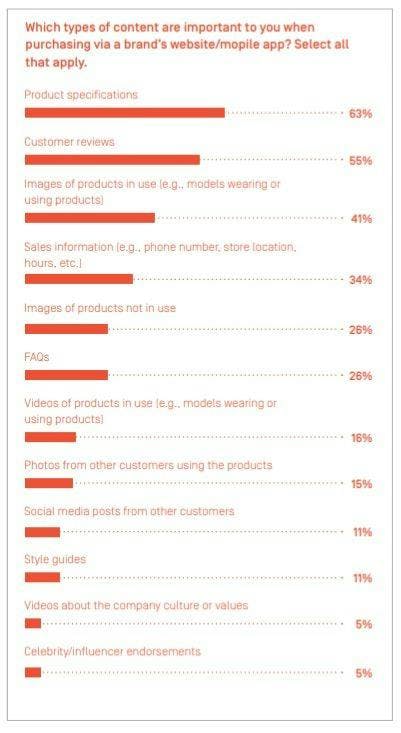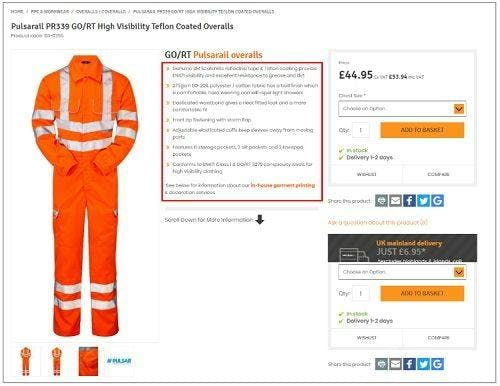Your site is ranking well and visitors are landing on your product pages. At this point, many people think they can just sit back and wait for the orders to start coming in.
However, with more than half of consumers ‘showrooming’ to check prices before making a purchase, you risk missing out on sales if your product pages aren’t optimised.
An optimised product page means making the product easily discoverable both on your site and in search as well as providing visitors with all of the information to give them confidence to make a purchase.
An optimised page should include:
- Clear product name
- High quality photography
- Trust seals (such as an SSL certificate badge and awards)
- Customer reviews
- Detailed, informative product descriptions
In this blog post, we will focus on the last and arguably the most important point on this list - product descriptions. Read on to discover how you can use these to your advantage and curate an e-commerce site that will really sell.
What is a Product Description?
A product description is the content featured on a product page that describe the features of the item.
Including detailed product information across your website is important whether you sell a small offering or if you have large e-commerce store with hundreds of product.
It’s important for two main reasons:
- Including descriptive text across your site will incentivise Google to rank you higher in the search engine results page (SERPs)
- Quality content will help to convert site visitors into paying customers
In fact, research by Salisfy found that 87% of consumers rate product content extremely or very important when deciding to buy online.
Additional research from Episerver’s 2018 Reimagining Commerce study found that online shoppers rated product descriptions as more important than customer reviews, FAQs or even images of the product.

Episerver’s Reimagining Commerce study
If you want to build trust and get site visitors to open their wallets, you need to give them all the details that you can to make an informed decision.
3 Rules For Writing Product Descriptions
1. Know Your Audience
The most important step to follow when writing product descriptions is to write content with the target audience in mind.
The type of information you would expect to find on a product page will differ depending on the industry you’re in and the type of product you’re offering but no matter what, you’ll need to consider who is searching for the product and what problem the product will solve for them.
When writing content, keep the following questions in mind:
- How do visitors end up on your site?
- Why would they be interested in this item?
- What features of the product would be most interesting to your target audience?
You also need to think more broadly about who the customer is as this will help you to work out how you should be communicating with them. Depending on who they are will determine the tone your content should take.
Some audiences will look for fun, humourous content, but if you’re selling a product based on safety features or dealing with financial products, the audience will look to your content to inspire confidence in the product.
If you’re not sure who you’re dealing with, you can download our Brand Voice template here to work it out.
2. Detail the benefits, not just the features
One you’ve worked out who your audience is, you can begin writing product descriptions that are tailored to that audience.
This means that instead of simply listing the specifications supplied by the manufacturer, you need to think about why those specs would make the item on offer superior to other options the customer might be considering.
This is something that Safety Buyer have excelled at. Their product descriptions provide the specifications explained in the context of why that makes this a worthwhile purchase.
For example, the description for the Pulsarail PR339 GO/RT High Visibility Teflon Coated Overalls could have simply said “275gsm 80-20% polyester / cotton fabric” but SafetyBuyer go on to explain that this choice of fabric means that the item is “comfortable, hard wearing and will repel light showers”.

By breaking each specification out like this, Safety Buyer is able to explain why this product is the right one for someone who might be new to the industry.
As Safety Buyer is a stockist and not a manufacturer, this same product will also be available from other retailers.
Building upon the supplied specifications ensures that their product descriptions are unique in the eyes of Google, as well as setting Safety Buyer apart from the competition.
3. Make it Readable
While the advice given so far can be summed up as “provide the customer with all the possible information they might need to make a purchase”, it’s vital that the information is presented in a way that allows them to easily take in the information.
Many of the rules from Econsultancy’s guide to writing for the web apply when writing product descriptions as well as blog posts and news stories. The rule about keeping sentence and paragraph length down is particularly relevant.
As the description box on a product page is likely to be much smaller than the text area would be on a blog post, it’s arguably more important to keep your content concise.
The best way to do this is to make the content skimmable, either by using bullet points or breaking the description down into different headed sections.
If your content isn’t easily readable, it might as well not be on the page as the majority of people simply won’t read it.
How I-COM can help
Getting your descriptions right will take creativity and, depending on the number of products you have, can be very time consuming.
However, when combined with a wider marketing strategy, having unique product descriptions can have a significant increase on the number of sales your website makes. Take a look at our case study for SafetyBuyer to see what impact having the right approach to product descriptions can have.
Product page rewrites were a part of our approach that helped increase revenue by over 23% year-on-year for one of our e-commerce clients. To find out more about our content writing services and what we can do to get the most out of your site, click here or call us at 0161 402 3170.
Need help with digital marketing? Get in touch!
I-COM Digital Marketing
With a large in-house team of specialists we provide a range of digital services including web design, web development, digital marketing, SEO, branding, content marketing, PR and outreach, social media marketing and paid search marketing, we cover every digital marketing need you may have.
Call us on 0161 402 3170 or use the contact form to get in touch.
